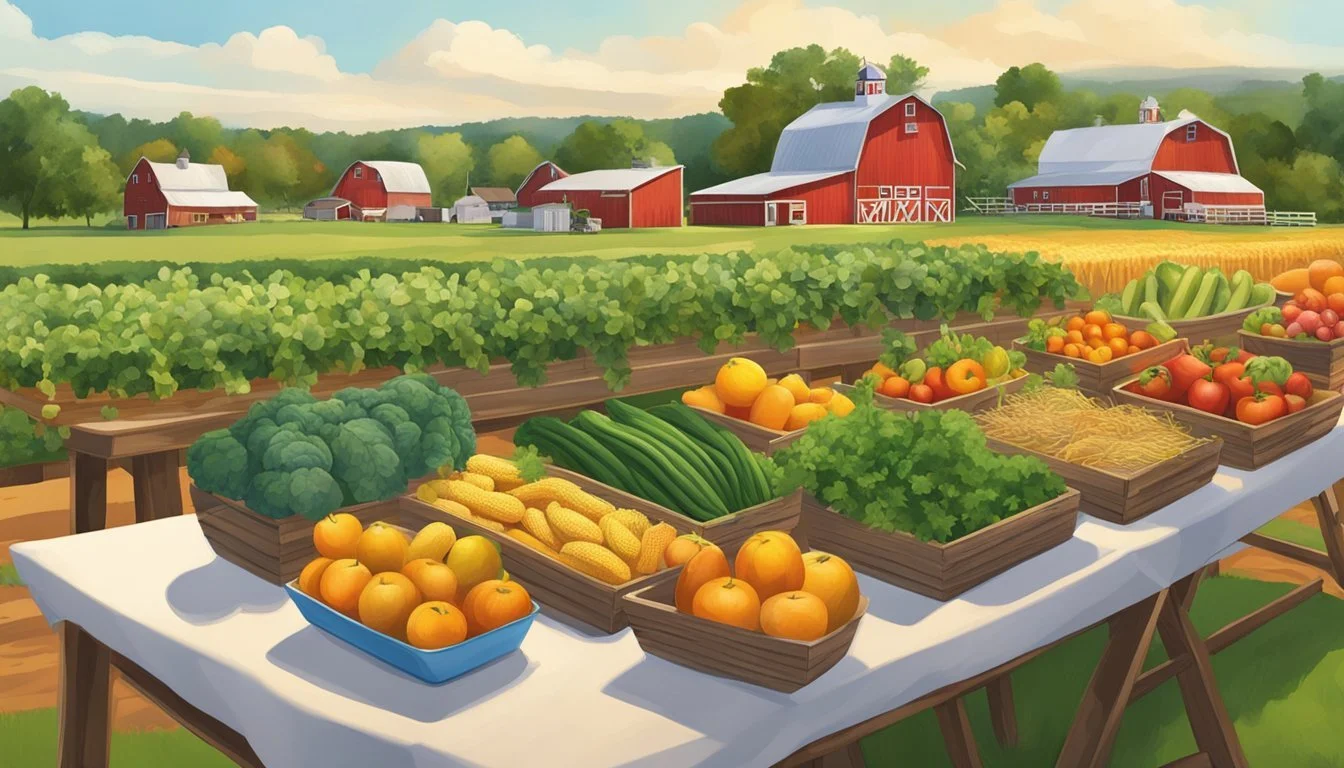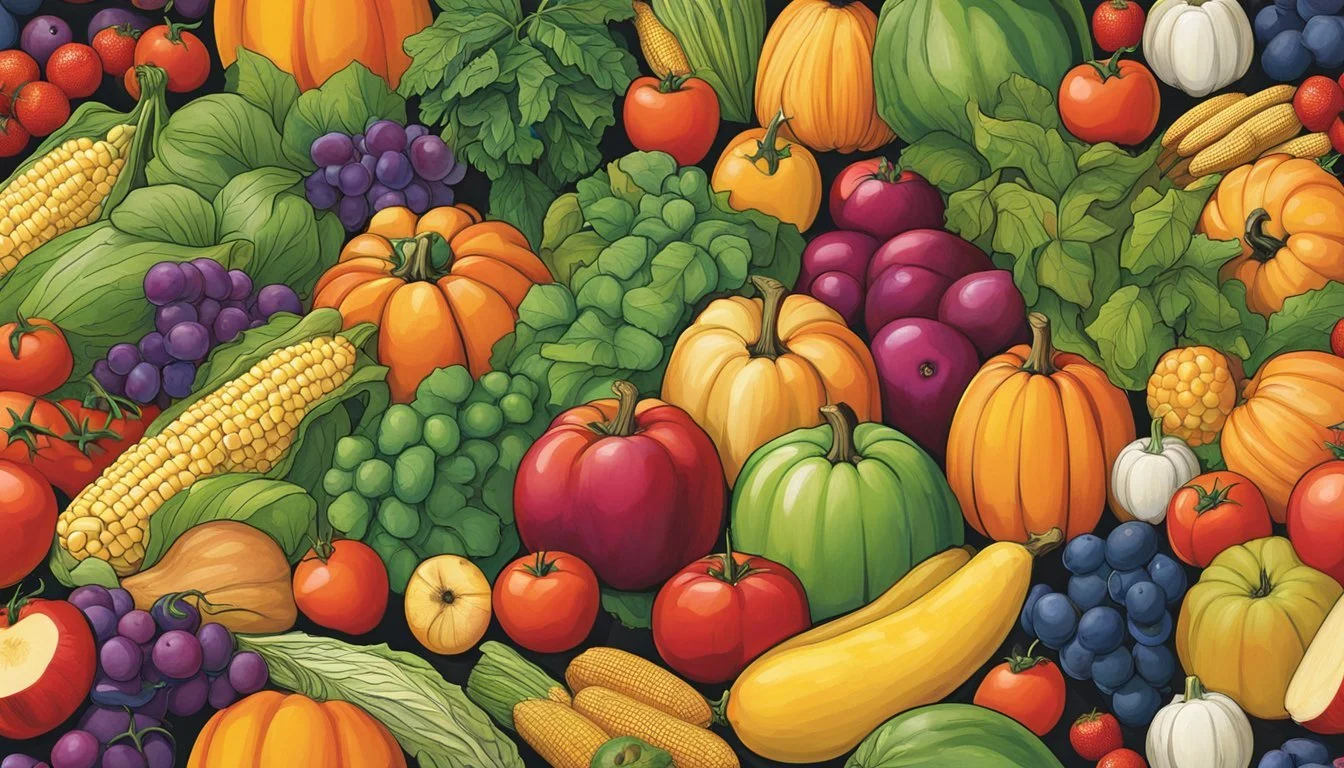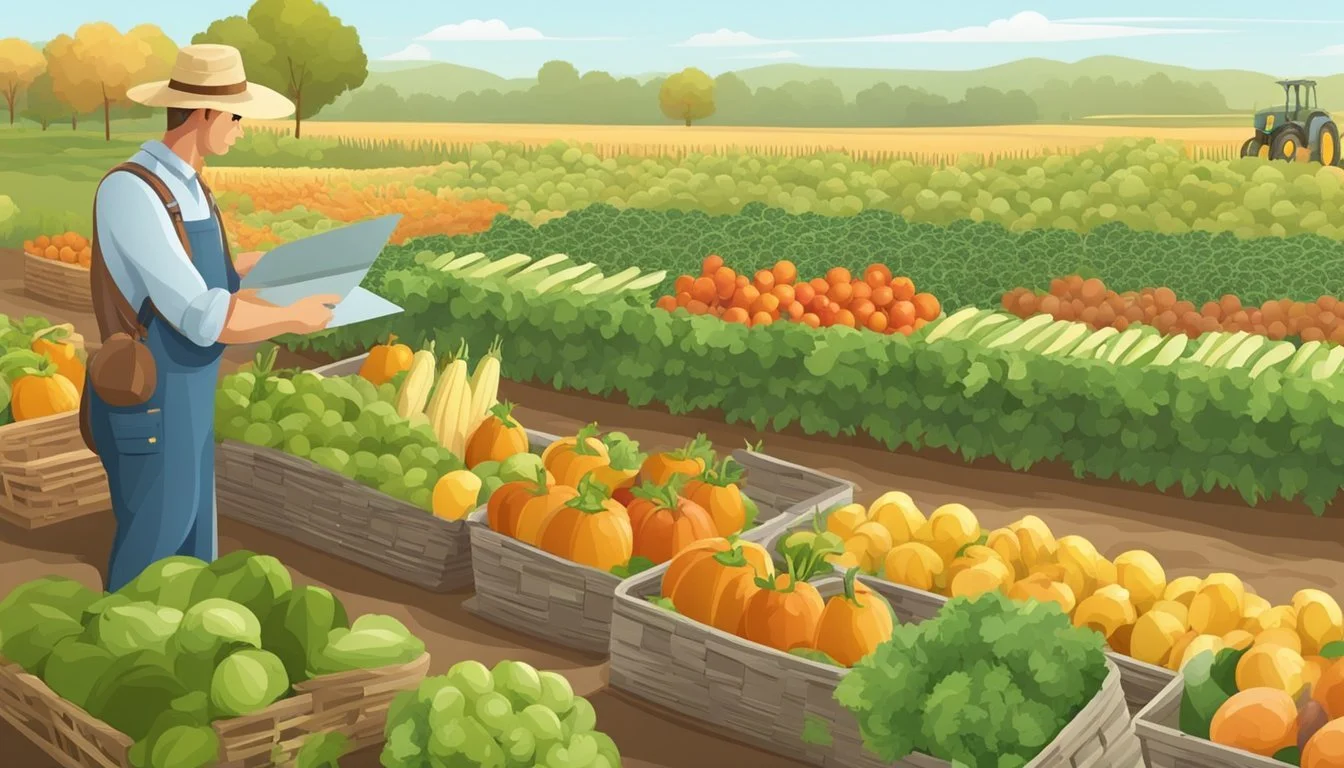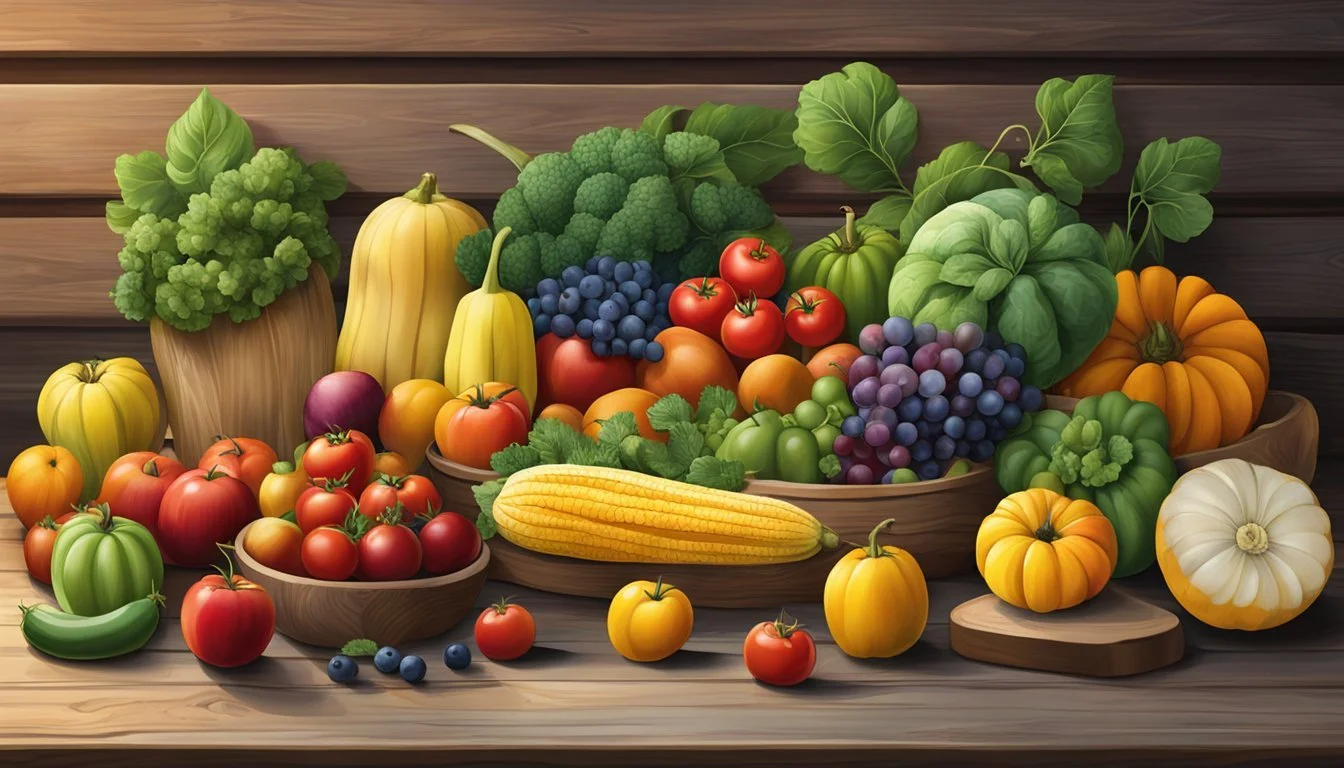Wisconsin Seasonal Fruit & Veg Guide
Your Ultimate Planning Resource
Wisconsin's rich agricultural heritage and diverse climate contribute to a wide array of produce that locals and chefs eagerly anticipate each season. From the tart cherries of Door County to the crisp apples (how long do apples last?) of the Driftless Area, the state is abundant with farm-fresh fruits and vegetables. Eating seasonally in Wisconsin not only brings a fresher and more flavorful experience to the table but also supports the local economy and reduces environmental impact from long-distance food transport.
With each passing season, a new selection of produce becomes available, offering culinary enthusiasts the opportunity to create a farm-to-table experience right in their own homes. In the spring, asparagus (What wine goes well with asparagus?) and rhubarb make their brief yet coveted appearance. As the days grow longer and warmer, summer ushers in a profusion of berries, cucumbers, and sweet corn. The autumn harvest welcomes a bountiful array of squash varieties, root vegetables, and the celebrated cranberry, a staple in Wisconsin's agricultural landscape.
Fruit and vegetable connoisseurs, as well as those new to the delights of seasonal eating, will find the rolling hills and fertile plains of Wisconsin a treasure trove of agricultural produce. A seasonal guide is an indispensable tool for those looking to incorporate local and seasonal vegetables and fruits into their cooking repertoire, offering insights into peak harvest times and the freshest ingredients available throughout the year.
What’s in Season in Wisconsin Right Now?
Understanding Wisconsin's Seasonal Produce
Wisconsin's diverse climate shapes a distinctive cycle of seasons, each offering a bounty of specific fruits and vegetables. The following sections unravel the nuances of these agricultural periods.
Introduction to Wisconsin's Growing Seasons
In Wisconsin, the growing season typically commences in spring with the ground's thawing and extends into fall, when the cooler temperatures begin. The heart of Wisconsin's produce availability flourishes in summer, with a myriad of fruits and vegetables ripening under the long, warm days. Key crops such as berries become ripe in summer's embrace, while the autumnal transition brings forth a variety of squashes and root vegetables.
Spring can be unpredictable but it heralds the arrival of leafy greens and asparagus. Summer boasts an abundance of berries, including blueberries from early July to mid-August, and continues with corn, tomatoes, and peppers. Fall captures the essence of apples, pumpkins, and cruciferous vegetables like Brussels sprouts, leading into winter where storage crops and indoor-grown produce like mushrooms still contribute to the state's farm-to-table scene.
Climate and Crop Variability
Wisconsin's climate is largely continental, with cold winters and warm summers, but this can vary significantly across the state, impacting the growth and availability of local produce. Factors such as weather conditions, farm location, and specific crop varieties grown influence the harvest timelines and the quality of the yield. For example, weather fluctuations can either shorten or extend the blueberry season in the upper half of the state.
Moreover, there are staple foods available year-round due to indoor farming techniques, storage capabilities, and hardy varieties that can withstand harsher conditions. The state's farmers utilize technology and traditional methods to ensure a constant supply of items like cheese, milk, eggs, and dry beans irrespective of the season's challenges.
Spring Harvest
Wisconsin's spring harvest ushers in a fresh wave of produce, with May bringing the first delights of the season. Residents and chefs alike eagerly await the arrival of crisp vegetables and tart fruits that signal the end of winter.
May Delights
In May, Wisconsin farmers markets begin to showcase an array of freshly harvested produce. Two standout items during this month are:
Rhubarb: With its tart flavor, it's a favorite for pies and desserts.
Asparagus: This versatile vegetable is known for its tender stalks and is a sign of spring.
Early Season Vegetables
Early in the season, Wisconsin's soil yields a variety of vegetables. The list below highlights some of the earliest harvests, including the much-anticipated asparagus:
Asparagus: Harvested when the shoots are just right, each spear offers a tender, earthy bite.
Leafy Greens: Varieties such as spinach and kale begin to flourish, providing a base for spring salads.
Radishes: These crisp, peppery roots add a zesty kick to dishes.
Spring Fruit Specialties
While the fruit selection is more limited in spring, there are specialties that one can enjoy:
Rhubarb: It stands alone as a spring fruit specialty. Often paired with strawberries, it gains sweetness and is perfect for compotes and jams.
Summer's Bounty
The warm summer months in Wisconsin bring a diverse range of fresh produce to the table, with berry farms bustling and vegetable patches teeming with life.
Berries Galore
During the summer, strawberries make their sweet debut in June and are followed closely by blueberries and raspberries. Berry farms offer ripe, juicy fruits that are perfect for fresh eating, preserves, or baking. Patrons have the opportunity to visit these farms for a hands-on experience, partaking in the summer tradition of berry picking.
Fruits to look for:
Strawberries: Early to mid-June
Blueberries: July through August
Raspberries: Mid-July to August
Essential Summer Vegetables
Vegetables are no less abundant. Staples such as corn reach their peak during the summer. They are a key feature at farm-to-table events, known for their sweetness and versatility. Other essential vegetables that thrive in the summer include tomatoes, peppers, and cucumbers, all of which play a significant role in the seasonal culinary palette.
Key vegetables:
Corn: Best from July onward
Tomatoes: Available throughout summer
Cucumbers: Peak in midsummer
July's Peak Harvest
July stands out as a month of abundance when the harvest reaches its zenith. Farms are laden with the freshest summer produce, from fruits like cherries and apricots to a full range of vibrant vegetables. This period marks a banquet for both locals and visitors, who can savor the freshest flavors directly from the source.
Notable harvests in July:
Stone fruits: Cherries and apricots
Green beans: Tender and plentiful
Zucchini: A versatile summer squash
During this season, one can truly appreciate the bounty that Wisconsin's soil and climate offer, with a harvest that promises both flavor and nutrition.
Autumn Harvest
Autumn in Wisconsin is a season marked by an abundant harvest, with local orchards and farms bustling with activity. This is the time for apple picking, cranberry harvesting, and gathering the last of the late-season produce before the winter sets in.
Apple Season and Orchards
Door County stands out as a hub for apple picking in Wisconsin, with numerous orchards offering a variety of apples from mid-August through October. Visitors can choose from a range of apple types, each with their own distinct flavor suitable for eating fresh, baking, or making cider.
Popular Apple Varieties:
Honeycrisp: Sweet and crisp, perfect for eating raw
McIntosh: Tart and juicy, excellent for apple pies
Gala: Mildly sweet with a fine texture, good for salads and applesauce
Cranberry Harvest
Wisconsin takes pride in being one of the leading producers of cranberries in the United States. The harvest typically begins in late September and continues through October. The state's unique combination of sandy soil, abundant fresh water, and cool temperatures create ideal conditions for cranberries.
Cranberry Bogs: Visitors can witness the vibrant hues of cranberry bogs, where the berries are collected through a process called wet harvesting.
Late Season Produce
As fall sets in, farmers work to bring in the last of the late-season produce. This includes crops like pumpkins—essential for carving Jack-o'-lanterns and baking pies—and sweet corn, which is a staple at many autumn dinner tables. While blackberries typically wind down, you may still find some late harvests through the early part of the season.
Noteworthy Late Produce:
Pumpkins: For decoration or culinary use, available at pumpkin patches and markets
Sweet Corn: Best enjoyed fresh for its sweetness and tenderness
Winter Selections
In Wisconsin, winter doesn't halt the availability of fresh produce. Residents can still enjoy a variety of locally sourced fruits and vegetables, thanks to year-round indoor growing practices and the storage capabilities for root crops.
Year-round Availability
Indoor Farming: With advanced greenhouse technology, some Wisconsin farmers continue to grow and provide fresh produce like herbs and leafy greens throughout the colder months. These items are commonly found in local grocery stores and winter farmer's markets.
Winter Storage Crops
Potatoes and Cabbage: Hardy storage crops are a staple in Wisconsin's winter selection. As the names suggest, they store well in cool, dark environments, allowing for prolonged availability. A typical Wisconsin winter bounty would include:
Potatoes: A versatile root vegetable known for its ability to store well and nutritional value.
Cabbage: Durable and nutritious, cabbage stores well and is often used in winter dishes, such as stews and slaws.
Both of these crops can be found in various grocery stores across Wisconsin during winter, showcasing the state's ability to sustain local produce offerings even in the coldest months.
Wisconsin Farms and Food
Wisconsin's abundant farmland and commitment to fresh, locally-sourced food define its culinary identity, with a strong tradition of family-run farms and dairy excellence. Agricultural tourism thrives with opportunities for berry picking and experiencing dairy processes first-hand.
Family Farms and Berry Picking
Wisconsin is home to a plethora of family-run berry farms. These farms not only contribute to the local food supply but also offer a hands-on experience for visitors. Chet’s Blueberry Farm, for example, is notable for its variety, offering eight different types of blueberries. Berry picking season generally spans from early July through mid-August, when the berries are at their peak of freshness.
Typical Berry Picking Seasons:
Strawberries: June
Blueberries: July - August
Raspberries: August - September
Apples: September - October
The state promotes this activity through resources like Facebook pages and farm websites, making it easy for individuals to locate the nearest berry picking opportunity.
Dairyland's Cheese and Milk
Referred to as "America's Dairyland," Wisconsin takes pride in its dairy products, with an emphasis on quality and tradition. Farms around the state offer a firsthand look at the production of milk and the art of cheesemaking. Wisconsin produces more cheese than any other state in the U.S., and visitors can find an array of cheese varieties crafted by skilled artisans.
Famous Dairy Products:
Cheddar
Mozzarella
Specialty cheeses (e.g., Gouda, Havarti)
Family-owned dairies frequently organize tours, giving insight into dairy farming practices and the journey from farm to table — from milking cows to cheese aging cellars.
Farm to Table Philosophy
The farm to table philosophy is deeply ingrained in Wisconsin culture. Farmers and food producers maintain a commitment to delivering fresh, locally-sourced produce and dairy directly to consumers' tables. This approach fosters a sustainable food system and supports the local economy. Restaurants throughout the state proudly feature menus crafted around seasonal availability, showcasing the best of Wisconsin's harvest.
Key Components:
Local sourcing
Seasonal menus
Support for local Wisconsin farms
By integrating the farm to table concept, Wisconsin reinforces the connection between the land, the food, and the people, ensuring that the freshest and most flavorful ingredients are enjoyed by all.
Finding Local Produce
Wisconsin's rich farmland and diverse climates allow for a bountiful array of fresh produce throughout the year. Consumers are encouraged to explore various avenues such as farmers' markets and seasonal events to indulge in the local harvests' flavor and nutrition.
Farmers' Markets and Direct Sales
Farmers' markets are a mainstay in cities and towns across Wisconsin, offering a multitude of fresh fruits, vegetables, and artisanal goods. Many markets operate weekly, providing a consistent platform for local producers to sell their goods directly to consumers. The Dane County Farmers' Market in Madison, for instance, is renowned as one of the nation's largest, while smaller markets thrive in communities from bay to boundary.
Pick-your-own farms are another avenue for sourcing fresh produce, where visitors can handpick their favorites like strawberries and apples, depending on the season. A visit to places such as Rush River Produce on the Wisconsin/Minnesota border rewards visitors with a variety of berries, while Blueberry Haven in Bear Creek offers a similar experience for blueberry enthusiasts.
Regional Availability and Seasonal Events
Crop availability in Wisconsin can vary significantly by region and season. For example, Bayfield County is celebrated for its fruit farms, with a special emphasis on cherries and apples in the fall. Local agricultural calendars, often found at county extensions or growers' associations websites, provide detailed information about what's available and when.
Seasonal events are highlights of the agricultural year in Wisconsin. The state holds several festivals that coincide with harvest times, like the Warrens Cranberry Festival for cranberry harvests in late September. These events provide an excellent opportunity for visitors to engage with the local produce scene and purchase items at the peak of their freshness and flavor.
By utilizing calendars, attending local events, and frequenting farmers' markets, consumers can fully enjoy the breadth of local produce Wisconsin has to offer.
Planning and Preparation
When embarking on farm-to-table eating in Wisconsin, one must strategically plan for what produce is available throughout the year. By understanding the ripening dates of local crops, individuals can incorporate seasonal recipes into their meal planning, ensuring the freshest, most flavorful ingredients.
Seasonal Recipes and Usage
Chefs and home cooks alike benefit from a deliberate approach to seasonal recipes. Utilizing fresh, local produce not only contributes to a richer taste experience but also supports Wisconsin's agricultural community. For example, a spring recipe might feature asparagus and rhubarb, while late summer could highlight dishes with corn and cranberries. Cooks should check farm websites, as well as social media platforms like Twitter and Pinterest, for recipe inspirations tailored to seasonal crops.
Crop Ripening and Harvest Calendar
Knowing when fruits and vegetables are at their peak is crucial for planning. Here's a brief look at a harvest calendar that can aid in meal prep and shopping:
May through late June: Look for asparagus, rhubarb, and strawberries.
July to August: Summer squash, tomatoes, and blueberries are ripe for the picking.
September to October: Apples, cranberries, and pumpkins come into season.
It's advisable to visit local farm websites for specific ripening dates, as these can vary slightly each year due to weather conditions.
Community and Education
Wisconsin's seasonal farm-to-table movement is enhanced through community engagement and educational efforts that connect people directly with their local food sources.
Agricultural Tourism in Wisconsin
Door County, often referred to as the "Cape Cod of the Midwest," offers an array of agricultural tourism opportunities. Visitors can enjoy Lakeview Berry Farm near Sturgeon Bay for a hands-on experience in berry picking. The region's cherry orchards are particularly famous, with the farm providing a picturesque setting for learning about sustainable agricultural practices.
In Northern Wisconsin, Lake Nokomis Cranberries invites tourists and locals alike to witness cranberry harvesting up close. They offer educational tours that detail the cranberry growing process and the importance of this native fruit to the area's agricultural heritage.
Educational Resources and Social Media Presence
Educational resources in Wisconsin play a pivotal role in enhancing farm-to-table initiatives. Schools and community groups avail themselves of curriculum guides and toolkits, which help integrate local food sources into school menus and educational programs. These resources typically outline how to source locally grown fruits and vegetables in season and facilitate garden-based learning experiences.
Social media serves as a powerful platform for organizations to boast a strong presence, enabling them to promote seasonal eating and share Wisconsin-grown recipes suited for educational settings. These platforms also highlight community partnerships and events, bringing a wider audience into the fold of the farm-to-table conversation.
Additional Resources
For those seeking further information on farm-to-table produce in Wisconsin, county extension offices provide extensive local knowledge. They can be reached for guides specific to areas such as Bayfield County, which is known for its berry farms.
Social Media Platforms:
Facebook: Many farms have active Facebook pages where they announce harvest times, events, and offer tips for picking. You can find pages by searching for specific farms within Wisconsin.
Twitter: Follow farms, farmers' markets, and local food organizations for real-time updates on produce availability.
Pinterest: A source of inspiration for recipes and storing seasonal produce.
Berry Farms: Wisconsin's berry farms often update their websites with picking schedules, variety of crops available, and tips for visitors.
For a directory of berry farms in Wisconsin, visiting local tourism websites or agricultural sites can be helpful.
Cranberry Farms: As a significant cranberry producer, Wisconsin boasts several farms that may offer tours, especially during harvest season in the fall. Checking these farms' websites or contacting them directly could provide opportunities to learn more about cranberry cultivation.
Websites to Check:
Farm to Table Retailers: They usually have calendars listing when different fruits and vegetables are in season in Wisconsin.
Agricultural Extension Sites: They offer diverse resources, including seasonal availability charts and planting guides.
It's advised that interested parties verify seasonality and offer details through these resources as crop availability can vary due to weather and other factors.












